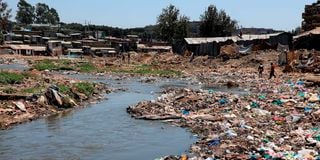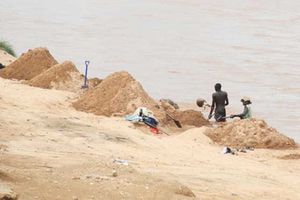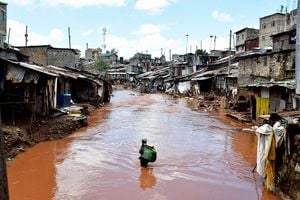
Waste dumped on a section of Nairobi River in this picture taken on September 15, 2024.
If you want to see the soul of a city, look no further than its river.
Nairobi, once the green city in the sun, holds the esteemed role of hosting the United Nations Environmental Program, yet for decades, the Nairobi River, as a symbol of life, has been anything but a reflection of environmental stewardship. Choked by pollutants and neglected by policy, this river’s murky waters tell a shameful tale of disregard and missed opportunity. Nairobi River, in a sense, reflects our politicians — and our politics: Murky, polluted, and stagnant.
Though Enkare Nyrobi, the “place of cool waters”, gave the city its name, it has now become a metaphor for how we’ve stifled the natural flow of life within the city itself. In 1899, when the Uganda Railway reached Nairobi, the river breathed life into the emerging town. Without the river, Nairobi would never have become the city it is today. The history of Nairobi is thus inseparable from the story of its waters. Today, it is an open sewer. It is known from colonial records that Nairobi was deliberately polluted when the new administrators made it a dumping ground of “night soils” and it later became the colonial sewer line – the way River Thames became a dumping ground of industrial and domestic waste in 1800.
Before the Uganda Railway carved its path through the region, the Nairobi River quietly marked the boundary between Maasai and Kikuyu lands. Its only crossing — a humble set of stepping stones — now lies beneath the museum’s bridge. The rest was papyrus reed and swamp well captured by writer Elspeth Huxley who described Nairobi a dusty “cart-track labeled Government Road,” lined with modest Indian dukas, and beyond was the frog-infested swamp where lions roamed the papyrus thickets, their numbers managed only by the steady rifle of the town’s founding administrator, John Ainsworth.
Nairobi River
I recently watched Environment Cabinet Secretary Aden Duale promise that within his tenure, the river will go back to its pre-city status. First, it is good to dream — and as Collin Powell once said, a “dream doesn’t become a reality through magic; it takes sweat, determination and hard work.” President Ruto’s recent appointment of the Nairobi River Regeneration Steering Committee stirs a flicker of hope, yet history reminds us that this is not the first effort to address the century-long environmental toll exacted by relentless polluters. The pressing question remains: how shall we rejuvenate the Nairobi River when we’ve permitted land speculators to grab the precious 4,000-acre Ruai sewage reserve, once earmarked to expand Nairobi’s sewerage treatment capacity?
We have not forgotten the contentious decision by Prof Kithure Kindiki, then Interior Cabinet Secretary, who, on December 15, 2023, handed over the Ruai sewerage land to private interests. Recently, Justice Ann Omollo overturned this action, ordering the Lands Registrar to nullify the title deed secured by Renton Company Limited. My question is: Where is the political will to tackle Nairobi River's pollution—if the same people in power are sabotaging the future of a functioning sewerage network? When Britain decided to clean up Thames, which had the same problem as Nairobi, it reached out to Britain’s number one engineer Sir Joseph William Bazalgette, now known as the saviour of the great stink. His duty, in 1853, was to get rid the city of cholera, rehabilitate Thames, and build a sewer system. That year, cholera had killed 15,000 people and within 9 years he had achieved all that.
President Ruto is not the first to dream of a pristine Nairobi River, and we, those who care about the river, will offer him support to clean it up. Since independence, no presidency has taken meaningful action to rescue this essential artery of our capital – though billions of shillings have been squandered on imagined mitigations. Mutula Kilonzo, under Mwai Kibaki promised that we would swim in the river. John Michuki only cleaned up a small section known as Michuki Park, an indicator that something can be done. Considering Ruto's delicate dance with the art of truth, we shall await the unfolding with patient reserve.
What is worrying is that the city has reached a point of irony so thick that it rivals the river’s sludge. President Ruto has enlisted an evangelist, rather than an environmental engineer, to give us a solution. I don’t object to “Dr” Margaret Wanjiru of Jesus Is Alive Ministries taking charge of Dr Ruto’s initiative. Nay. Perhaps, to the president, and in his political and ecclesiastical wisdom, Nairobi River needs something more than an engineering acumen — a spirited force or moral reckoning to breathe life back into its waters. But what does that say about our environmental commitment when we lean on prayer to tackle pollution instead of systemic reform and investment in expertise?
Environmental crisis
The state of the Nairobi River is not just an environmental crisis but a symbol of neglected civic responsibility and failure to reach out to engineers, and other experts, for a solution. And this failure has nothing to do with President Ruto, the current Nairobi Governor Johnson Sakaja, or Environment CS Aden Duale. But as citizens, we know that the team put together by President Ruto to rejuvenate the river system does not have the wisdom of engineer Sir Joseph William Bazalgette. At best, they are politicians looking for jobs. I rest my case. The nagging question is: If we cannot summon expertise to protect our river, a lifeline to both our ecosystem and the heart of Nairobi, what hope do we have of achieving broader environmental goals?
Duale should summon the bold spirit of the colonial entrepreneur and politician, Col Ewart Grogan, who, in 1906, embarked on a daring endeavour to tame the wild Nairobi swamp. In 1906, Grogan, undeterred by the swamp’s murky reputation, invested in the parcel of land that become the vibrant Grogan (now Kirinyaga Road). He named it Gertrude Swamp, in honour of the girl whose heart he had won after walking from Cape to Cairo.
Determined to transform the swampy land, Grogan hired a surveyor to drain and canalize the boggy expanse, converting it into valuable plots. He then leased these parcels to industrious Indian families, and turned the malaria-prone swamp into fertile ground for vegetable gardens and budding homesteads. By 1910, Grogan’s vision was taking shape—he bought out his partner for £3,000 as his once-overlooked swamp transformed into prime real estate. When Nairobi’s Municipal Council sought to buy the land in 1929, Grogan held firm. What we learn from that story is that Nairobi River can be rescued – and we should start from the source at the Ondiri Swamp in Kikuyu.
Read: After the floods...
Once the sacred source of the Nairobi River, this cherished wetland, which used to be called Kihenia by Kikuyu, has battled years of pollution. But amid these challenges, the Friends of Ondiri — a dedicated group with an unwavering mission to restore the swamp to its original glory — have emerged as its guardians. Through their efforts, they have revived what colonial settlers rebranded as "Old Lake," a name that later morphed into “Ondiri”. Now, thanks to their tireless work, Kihenia struggles to lives on, and might one day reclaim its place.
If we want to learn, there are small victories by Friends of Ondiri, John Michuki, and Ewart Grogan and many others who have tried to save the river – and not from the pulpit.












